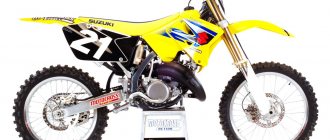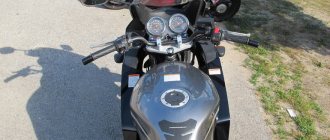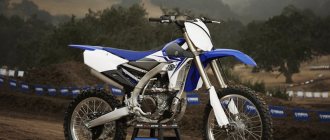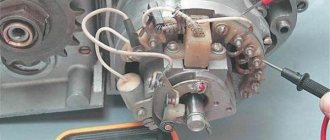Cheset 350: technical characteristics
The main power plant is a two-stroke engine with 2 cylinders. The cylinder arrangement is in-line. The working volume is 343 cc. At the same time, the motor is capable of producing 22 hp. The Port control function was used as a distribution system. The engine receives the necessary cooling due to the oncoming air flow.
The transmission consists of 4 gears. The main transmission is a metal chain. Drum brakes are installed at the front and rear of the motorcycle. Front and rear wheel sizes respectively: 3.25-18 and 3.50-18. The fuel tank is designed for 18 liters of fuel. The motorcycle is capable of reaching a maximum speed of 125 km/h.
Transmission
A multi-day motorcycle needs a higher maximum speed than a motocross bike and a slightly different distribution of torque among gears. Therefore, it is necessary to change the gear ratio of the motor transmission, gearbox and final drive.
Rice. 1. Motor transmission gears : a - driven (56 teeth); b - drive (20 teeth) and fourth gear: c - driven (15 teeth, pitch circle diameter 37.5 mm); g - drive (22 teeth, pitch circle diameter 55 mm). Module M-2.5; the original contour according to GOST 13755 is 68, its displacement coefficient is +0.8. Material - steel 12ХНЗА, cement to a depth of 0.4 - 0.6 mm, heat until hardness HKS = 54 -56.
We produce gears with 56 and 20 teeth according to Fig. 1. They will replace the 53 and 23 tooth gears of the motor transmission. The most suitable material is 12ХНЗА steel. In the box, to change the gear ratio of the second and third gears, we use two pairs of standard gears (17 and 20 teeth) for the third gear, and for the fourth we make new gears (see Fig. 1). We assemble the box as shown in Fig. 2. Since the order of gear engagement becomes different, we make a new selector plate according to Fig. 3. After assembling the box, we use washers to adjust the depth of connection of the side cams of the gears and achieve precise gear engagement.
Rice. 2. Layout of gears in the gearbox: 1 - input shaft; 2 — first gear gears; 3 — second gear gears; 4 - third gear gears; 5- - fourth gear gears. The numbers on the gears indicate the number of teeth.
To increase speed when driving on the highway, it is advisable to replace the main (rear) gear sprocket, which has 60 teeth, with a new one - with 53 or 55 teeth.
Rice. 3. Gear selector plate. Material - 12KhNZA steel, cemented to a depth of 0.4-0.6 mm, hardened to hardness HKS = 55 -58.
ChZ keeps pace
In recent years, competition in motocross competitions has intensified, especially in the 250 cc class. Today, a good two dozen companies in different countries produce such motorcycles for club racers. The technical performance of the cars has become much closer, and designers have to update sports cars almost every year.
For 1979, the Czechoslovakian CZ plant included an improved model CZ 977.3 in its production program. Changes compared to the well-known ChZ-980 car affected the exhaust system, front and rear forks, the location of the spokes in the wheels, the chain tensioner, and the front wheel brake.
Electrical equipment
The standard ignition system with two simultaneously operating high voltage circuits has proven its worth in multi-day competitions. The source that powers the ignition and lighting circuits remains the alternating current generator (6 V, 60 W). By increasing the gear ratio of the motor transmission, reliable engine starting from the kick starter is ensured. A headlight with a diameter of at least 100 mm with low and high beam lamps is used from any motorcycle or moped.
The brake light switch, borrowed from road motorcycles, is mounted on the back of the right-hand bib and is connected by a spring to the footbrake lever.
We take power for the lighting circuits from the low voltage contact of one of the ignition coils.
What is the maximum speed of the CZ-250
All sorts of topics related to socialist camp motorcycles
Moderator: Neposeda
ZaURALets Messages: 1327 Registered: 11/15/2009 From: Dnepr #46 Post by ZaURALets » Mon Feb 14, 2011 1:44 pm
For CZ-250/513 . Cluster frequency at Ne max-7800 rpm Motor transmission-21/55 4th front-19/18 Before chain-14/58 Rad. quality wheels-0.34m We get kinematics. speed Vmax=97.3 km/h . With a star at 15 Vmax=104.2 km/h Cz-380/514 At n=6800 and 14/52 Vmax=120 km/h
vitaharu Posts: 89 Registered: 09/07/2010 From: Kramatorsk #47 Post by vitaharu » Mon Feb 14, 2011 8:46 pm
Well, it finally looks like the truth!!!!!
ZaURALets
vova63
Messages: 603 Registered: 11/28/2010 From: Uman
#48 Post by vova63 » Mon Feb 14, 2011 9:06 pm
Destroyer
Destroyer wrote: vova63 , 400ku.
And this is not the end... There is something to strive for)))
I had no doubt about the engine...
I mean to keep this good on the road at such
speed..160 he goes to half throttle..what to do next
like this moto design
moto
kiryukha
Messages: 3316 Registered: 11/09/2009 From: Ukraine, Krivoy Rog
#49 Post by Kiryukha » Mon Feb 14, 2011 9:26 pm
what to do!
pray blah!
You can say the word halva a thousand times, but it won’t make it any sweeter in your mouth...
Avtokor
Messages: 1602 Registered: 05/06/2010 From: Sumy region
#50 Post by Avtokor » Mon Feb 14, 2011 9:29 pm
since the user Destroyer was banned, he asked to transfer)
vitaharu , but on the graphs is the speed not so high?))) vova63 , the chassis has been rebuilt, all the bearings are new. I also plan to get new shock absorbers.
vova63
Messages: 603 Registered: 11/28/2010 From: Uman
#51 Post by vova63 » Mon Feb 14, 2011 9:44 pm
but the fact of the matter is that, believe me, I also worked on everything on the chassis down to the smallest detail...165 and it blows like an aspen leaf in the wind. opticator... in my opinion this is the only option... I don’t see any more options... or make the motsyk heavier...
moto
maxbel
Messages: 241 Registered: 08/26/2010 From: Lugansk
#52 Post by maxbel » Tue Feb 15, 2011 12:15 am
Guys, if we wouldn’t play along, it’s clear that 150 won’t go, I probably drove a maximum of 75 kilometers on my Cheze. This is generally a stupid question “WHAT IS THE MAXIMUM SPEED OF THE CHZ” everyone understands that depending on what goals you set, what do you need speed or explosive dynamics? And this all depends on the selection of gear ratios of the stars (driven, driven and motor), as well as the number of gears, and the type of tires.
kiryukha
Messages: 3316 Registered: 11/09/2009 From: Ukraine, Krivoy Rog
#53 Post by kiryukha » Tue Feb 15, 2011 12:45 am
but here we were talking about the standard ratio of stars!
You can say the word halva a thousand times, but it won’t make it any sweeter in your mouth...
vova63
Messages: 603 Registered: 11/28/2010 From: Uman
#54 Post by vova63 » Tue Feb 15, 2011 1:38 am
well, if we are talking only about the chz-cross 250, then it’s well tuned
110 will work... but not for long
will jam anyway
moto
leonmotoblock
Messages: 716 Registered: 04/13/2010
#55 Post by leonmotoblock » Mon Mar 14, 2011 1:23 pm
But if you attach a sports pipe to the resonator and change all the stars to road ones and lower the suspension to reduce the ground clearance, then it will work?
0678873819,0636226446
RM-Z 450 '11 RM-Z 450 '06 ZX-10R '06
Destroyer
Messages: 992 Registered: 07/18/2010 From: Ivano-Frankivsk
#56 Post by Destroyer » Mon Mar 14, 2011 2:29 pm
What will a pipe from a sport to a resonator give you? The engine won't work there if you replace it with road sprockets. I already counted.
Spoke wheels: manufacturing, alignment. Boosting and tuning of 2T engines. Computer embroidery. Tuning electronic ignition, FUOZ.
leonmotoblock
Messages: 716 Registered: 04/13/2010
#57 Post by leonmotoblock » Mon Mar 14, 2011 2:52 pm
I was thinking about pushing down the power in order to draw out the resource so that it wouldn’t work...
0678873819,0636226446
RM-Z 450 '11 RM-Z 450 '06 ZX-10R '06
Destroyer
Messages: 992 Registered: 07/18/2010 From: Ivano-Frankivsk
#58 Post by Destroyer » Mon Mar 14, 2011 6:58 pm
Then it won't last any more.
Spoke wheels: manufacturing, alignment. Boosting and tuning of 2T engines. Computer embroidery. Tuning electronic ignition, FUOZ.
leonmotoblock
Messages: 716 Registered: 04/13/2010
#59 Post by leonmotoblock » Mon Mar 14, 2011 9:15 pm
It’s strange I saw on the net a Java 638 with a 981 engine under a cafe racer with a small star in the rear and a large one in front and a slightly muffled lower resonator of the old model. I really liked it, there’s even a video on YouTube of how it works
0678873819,0636226446
RM-Z 450 '11 RM-Z 450 '06 ZX-10R '06
Destroyer
Messages: 992 Registered: 07/18/2010 From: Ivano-Frankivsk
#60 Post by Destroyer » Mon Mar 14, 2011 10:48 pm
Let's take a look at the link. I'm not saying that it won't go. But I say that it won’t go more than 120)
Spoke wheels: manufacturing, alignment. Boosting and tuning of 2T engines. Computer embroidery. Tuning electronic ignition, FUOZ.
Let's start with the fact that my brain was enslaved by the idea of endurism, but in principle I’m not ready to change a road motorcycle to a “dirt” one (in my understanding, enduro is exactly what it should be), and the family budget is not quite ready to buy an enduro for >100 thousand, as well as contain both. and it’s not a fact that I’ll need it after the first trip))) Anyway, one day I was mulling through an ad, I came across a sale of a CZ-513 (with a 250cc engine) for a very budget price, but with a completely dead engine (to replace the crankshaft, CPG, clutch) which had been standing in the barn for about 10 years. The thought flashed through my mind - shouldn’t I try it... An hour later, with a fellow teammate in his 4k we were driving 150 km to pick up a motorcycle... In this form I saw him for the first time
visually it was in an obscene state, to put it mildly, the engine cranked with a crunch, there was no compression... but for such a price tag I was of little interest! For me, only the chassis in it was valuable...
the motorcycle was brought home
the engine was removed, the prices for spare parts made the hairs on end stand on end not only on the head... the Japanese are cheaper to repair, and after studying more detailed information, it was decided to abandon this engine altogether, because... its service life is 12-15 hours, which did not satisfy me at all
The motor was lying around in the garage, then in the spring it was donated to the guys from the motocross section... I think it is more needed than for me the motorcycle was completely disassembled. washed The suspensions were rebuilt, and the search began for an engine suitable specifically for enduro (high-torque, reliable)... and most importantly, inexpensive and unpretentious... Initially, there was an option for the IZH PS engine... but within Siberia it is extremely difficult to find one. so the motor was found. or rather, several from IZH Planet of various modifications, one was literally dug out of the ground behind the garage of the owner of this miracle... a small problem was that the Planet engine was 7 cm longer than the original engine... but I still managed to put it into the frame without violating its integrity
it was already autumn, there was absolutely no time to work on the motorcycle, everything was put on the back burner... around February, remembering that the motorcycle season was coming, active work began on weekends... The engine was fixed, the exhaust was welded - just from pipes, I started working on the resonators now , in order to regain the lost power... it was made from pipes, so as not to miss the mud season...
Time passed and then it came to the first launch... temporary wiring was installed. just to start the engine
started up and worked quite well... in the process of manufacturing this miracle, the engine acquired different positions... it was even like that
Then the box was glued together from epoxy and fiberglass, and installed in place of the standard air filter, it housed all the electrics - the battery, all the wires and the power supply unit, and the already manufactured air filter was placed on top of it.
in the end the motorcycle acquired its new look
To summarize, I’ll say that it turned out to be a good, good motorcycle, very high-torque (due to the ratio of the stars, the first gear turned out to be just a tractor), a spring from the UAZ clutch basket was added to the front fork in order to increase its rigidity a little - after all, the engine is noticeably heavier than the original one, and I weigh 103 kg … the suspension works just great! Well, the name of the motorcycle was given by crossing two “CZ and IZH” and the result was CHIZH (CHIZH)
See you on the roads, friends!
Motorcycles "Chezet"
It’s worth starting by getting to know the Chezet motorcycle as such. What kind of vehicle is this? In fact, everything is quite simple - these are motorcycles of Czechoslovak and then Czech production, which are called that only in Russia. “Chezet” is rather a nickname, because the original name is Česká zbrojovka Strakonice. Naturally, Russian people do not want to use such a name in their everyday speech, so he decided to simplify everything by shortening the name to indicate the country of production, that is, CZ. Well, then, if you pronounce these letters, then you get “Chezet”.
This plant has been operating since 1932 and initially concentrated on the production of mopeds. However, he quickly moved on to motorcycles, and in 1935 the first model appeared. Until 1998, the plant operated, producing a wide variety of motorcycles that became popular in Russia. Which Cheset motorcycle do you remember the most? Which was the first and which was the last?
Supply system
The standard "Yikov-2932" carburetor fully ensures normal engine operation in different modes if you use the main jet "135-140" and the idle jet "60-65".
The domestic K-194 carburetor also gives good results, but to install it you have to redo the pipe. To increase strength, it is advisable to cover the air purifier body with a layer of fiberglass with epoxy resin (ED-5, ED-6, K-153).
The muffler is located at the top.
Instead of a standard fuel tank, another, larger capacity (about 12 liters) is used, for example from a motorcycle IZH-11M or MTs-250.
Brief history of the model
- 1974 - start of production and sales. First generation
.
Model
: Kawasaki KX125 (North America).
Factory designation:
KX125-A1.
- 1975 - no significant changes.
Model
: Kawasaki KX125 (North America).
Factory designation:
KX125-A2.
- 1976 - no significant changes.
Model
: Kawasaki KX125 (North America).
Factory designation:
KX125-A3.
- 1978 - no significant changes.
Model
: Kawasaki KX125 (North America).
Factory designation:
KX125-A4.
- 1979 - no significant changes.
Model
: Kawasaki KX125 (North America).
Factory designation:
KX125-A5.
- 1980 - no significant changes.
Model
: Kawasaki KX125 (North America).
Factory designation:
KX125-A6.
- 1981 - no significant changes.
Model
: Kawasaki KX125 (North America).
Factory designation:
KX125-A7.
- 1982 - restyling of the model. Second generation
.
Model
: Kawasaki KX125 (North America).
Factory designation:
KX125-B1.
- 1983 - no significant changes.
Model
: Kawasaki KX125 (North America).
Factory designation:
KX125-B2.
- 1984 - restyling of the model. Third generation
.
Model
: Kawasaki KX125 (North America).
Factory designation:
KX125-C1.
- 1985 - restyling of the model. Fourth generation
.
Model
: Kawasaki KX125 (North America).
Factory designation:
KX125-D1.
- 1986 - restyling of the model. Fifth generation
.
Model
: Kawasaki KX125 (North America).
Factory designation:
KX125-E1.
- 1987 - no significant changes.
Model
: Kawasaki KX125 (North America).
Factory designation:
KX125-E2.
- 1988 - restyling of the model. Sixth generation
.
Model
: Kawasaki KX125 (North America, Europe, Japan).
Factory designation:
KX125-F1.
- 1989 - restyling of the model. Seventh generation
.
Model
: Kawasaki KX125 (North America, Europe, Japan).
Factory designation:
KX125-G1.
- 1990 - restyling of the model. Eighth generation
.
Model
: Kawasaki KX125 (North America, Europe, Japan, Australia).
Factory designation:
KX125-H1.
- 1991 - no significant changes.
Model
: Kawasaki KX125 (North America, Europe, Japan, Australia).
Factory designation:
KX125-H2.
- 1992 - restyling of the model. Ninth generation
.
Model
: Kawasaki KX125 (North America, Europe, Japan, Australia).
Factory designation:
KX125-J1.
- 1993 - no significant changes.
Model
: Kawasaki KX125 (North America, Europe, Japan, Australia).
Factory designation:
KX125-J2.
- 1994 - restyling of the model. Tenth generation
.
Model
: Kawasaki KX125 (North America, Europe, Japan, Australia).
Factory designation:
KX125-K1.
- 1995 - no significant changes.
Model
: Kawasaki KX125 (North America, Europe, Japan, Australia).
Factory designation:
KX125-K2.
- 1996 - no significant changes.
Model
: Kawasaki KX125 (North America, Europe, Japan, Australia).
Factory designation:
KX125-K3.
- 1997 - no significant changes.
Model
: Kawasaki KX125 (North America, Europe, Japan, Australia).
Factory designation:
KX125-K4.
- 1998 - no significant changes.
Model
: Kawasaki KX125 (North America, Europe, Japan, Australia).
Factory designation:
KX125-K5.
- 1999 - restyling of the model. Eleventh generation
.
Model
: Kawasaki KX125 (North America, Europe, Japan, Australia).
Factory designation:
KX125-L1.
- 2000 - no significant changes.
Model
: Kawasaki KX125 (North America, Europe, Japan, Australia).
Factory designation:
KX125-L2.
- 2001 - no significant changes.
Model
: Kawasaki KX125 (North America, Europe, Japan, Australia).
Factory designation:
KX125-L3.
- 2002 - no significant changes.
Model
: Kawasaki KX125 (North America, Europe, Japan, Australia).
Factory designation:
KX125-L4.
- 2003 - restyling of the model. Twelfth generation
.
Model
: Kawasaki KX125 (North America, Europe, Japan, Australia).
Factory designation:
KX125-M1.
- 2004 - no significant changes.
Model
: Kawasaki KX125 (North America, Europe, Japan, Australia).
Factory designation:
KX125-M2.
- 2005 - no significant changes.
Model
: Kawasaki KX125 (North America, Europe, Japan, Australia).
Factory designation:
KX125-M3.
- 2006 - no significant changes.
Model
: Kawasaki KX125 (North America, Europe, Japan, Australia).
Factory designation:
KX125-M6F.
- 2007 - no significant changes.
Model
: Kawasaki KX125 (North America, Europe, Japan, Australia).
Factory designation:
KX125-M7F.
- 2008 is the last year of production.
Model
: Kawasaki KX125 (Europe, Japan, Australia).
Factory designation:
KX125-M8F.
What is 223 Rem Ammo?
Today, among Russian hunters who hunt small and large game, the Cheset 527 carbine, caliber 223, is especially popular. Reviews from owners of rifled weapons often mention excessive power and poor-quality flatness when shooting most hunting cartridges. This became the reason for the special demand for an intermediate cartridge with a reduced caliber. Since it is not allowed to use the military 5.45 mm AK-47 cartridge for hunting on the territory of the Russian Federation, hunters use its NATO analogue - both domestic and imported 223 Rem, designed for combat 5.56 x 45 mm.
Device
If we compare the characteristics and devices of the first model, it differs significantly from the subsequent ones.
After the start of mass production, the design of the pistol was changed:
- The front part of the bolt is narrowed;
- The trigger guard became smooth;
- Plastic pads appear on the handle;
- Spoke trigger instead of flat;
Today, the CZ pistol looks quite impressive, durable weapon-grade steel with an increased carbon content and a blued surface give the impression of a serious weapon.
In addition, a number of its features should be highlighted:
- Capacious box magazine for 14 rounds of 9*19 Parabellum (can be replaced with an enlarged one, holding 18 shots).
- Comfortable CZ 75 holster for everyday carry.
The automatic safety mechanism of the impact mechanism keeps the firing pin from contacting the cartridge case until the desired moment, this ensures safety from a possible shot when the CZ 75 Tactical falls on a hard surface.
The inertial impact mechanism also performs a similar action, preventing spontaneous shots.
The last motorcycle
As you already know, production of this type of transport at the plant was curtailed in 1998. But which model was the last? It turned out to be the Chezet Kagiwa Roadster 125 motocross motorcycle. They began producing it in 1994 and after four years of relative success, production was stopped, and with it the creation of motorcycles in principle.
It is worth noting that it was an impressive model in appearance, and its technical characteristics were excellent. But, probably, the Chesets have already outlived their usefulness, so nothing can be done about it. But many people are still trying to find a Cheset motorcycle, spare parts for it, and so on. Naturally, you can’t officially buy it anywhere, but it’s still quite possible to buy such a motorcycle second-hand.
Main differences from previous models
- Spacious fuel tank.
- Upgraded telescopic forks at the front (with black boots).
- Installed safety bars.
- Improved seat.
- Large headlight.
Models type 472.3 and 472.4 were equipped with small-volume gas tanks, which caused a lot of outrage among buyers. These tanks were suitable for sports motorcycles, but not for touring ones. From an ergonomic point of view, the shape of the tank was also unsuitable. The rear part of the tank was wide and caused inconvenience to the owner of the equipment in operation. The upgraded gas tank is designed for 18 liters of gasoline. Its shape has been changed, making travel more comfortable. Regardless of the driver’s configuration, sitting on the motorcycle does not cause discomfort.
Don’t forget about the telescopic fork at the front, which has undergone some changes. The lower pipes are made of light alloy, which in turn only had a positive effect on the price of the fork. Regardless of the operating conditions of the motorcycle, the fork works well both on small uneven surfaces and deep holes, bumps and potholes. In addition, travel has become safer. The fact is that it is very difficult to bring the fork to the bottom, dead-end position. Well, let us remind you about the new rubber covers on the fork, which prevent dust from getting into the middle of the fork. Due to this, the fork will serve for many years.
First motorcycle
The very first Cheset motorcycle that was produced at the plant was the CZ 175, which was born in 1935. It was a simple classic motorcycle that immediately attracted a lot of attention. As a result, its improved model was produced for the next two years, which was then replaced by a new one. However, it was the 175 that was remembered as the first and very interesting motorcycle; it was used throughout the Czech Republic and was also supplied abroad.
Needless to say, after production ended in 1937, this model was revived and updated in 1957 to be produced in several different trim levels over the next 12 years, and then periodically add new types until almost the end of production. This is not at all like the Chezet 350 motorcycle, which was produced only for two years. This model turned out to be very popular.
Converting the cross-country CZ-250 into a multi-day one
Multi-day motorcycle competitions are the most versatile form of motorsport. They require excellent physical fitness, cross-country and road bike skills from the rider, and reliability, good driving performance and endurance from the car. It is not for nothing that the international six-day competition is called the Motorcycle Olympics, thereby emphasizing its importance. In 1972, the Soviet team took fourth place at the six-day competition held in Czechoslovakia. This, of course, is a success: our athletes, like the winners, did not receive any penalty points in the main competitions (the winners were identified only by special tests). But to climb onto the podium, much remains to be done.
In our country, city, republican and all-Union multi-day races are held. The number of athletes participating in them is relatively small. The growth of mass popularity, in addition to organizational difficulties, is hampered by the lack of technically advanced motorcycles. Unfortunately. The Izhevsk and Kovrov plants, which previously produced motorcycles for multi-day racing, have practically stopped working on them, and the small number of MTs-250 machines received from the GDR, of course, cannot solve the problem. In order to still participate in competitions, athletes are forced to build their own or modify motocross and other motorcycles. Their work does not always produce the desired results. Many participants have to leave the track due to the imperfection of the cars.
The coaches and athletes of the Moscow national team found a successful solution. They adapt the widely used CZ-250 motocross motorcycle for multi-day competitions, which does not lose its best qualities and can return to its original form after a few hours of work.
Masters of sports Y. IVANOV and E. SUKHOMLIN talk about the alteration.
The modifications to which the ChZ-250 motocross motorcycle is subjected concern the transmission, chassis, power systems and electrical equipment.










